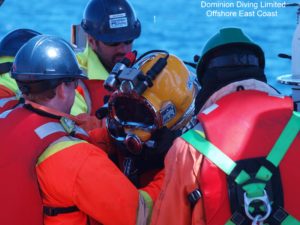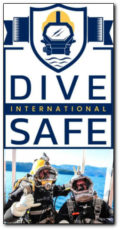When THREE is NEVER Enough :The movement to a Four Man minimum crew.
By CADC Admin ~ February 12th, 2018. Filed under: Latest Diving News, Safety, Standards and Regulations.
(Some jurisdictions in the diving industry allow for the use of a three-man dive crew on a jobsite. But, when you think of it, what is the operational position of this crew? Who is doing what? Let’s look at a typical three-man dive crew on a jobsite through the eyes—and voice—of the man in charge. That would be the supervisor, who is also filling in as the standby diver and the radio/rack operator. But, let’s hear it in his words. – Doug Elsey – CADC Exec Director)
“All jurisdictions and CSA state there must always be enough competent personnel onsite to safely dive. You cannot safely jump a standby diver with a three-man crew. There should be four qualified personnel, minimum, at any dive site. At no time should the supervisor lose control, especially in an emergency. If the supervisor is taking on the role of the standby diver, he/she will lose control, as we can see in the following scenario.
“It’s a beautiful day with a three-person dive crew; the diver is making good progress drilling 18-inch-deep holes with a 60 lb pneumatic drill, two-foot drill steel and a one-and-a-half-inch bit. I am the standby diver, supervisor and rack/radio operator. The tender is bored, keeping the umbilical free of pinch-points and watching the pedestrian traffic.
There has been no communication for over an hour; only the sound of the rock drill, the diver’s breathing coming through the radio and the two LP compressors running in the background.
A local lady calls down to us and says she has been watching us for the whole week and asked why there needs to be two workers on the surface doing nothing all day with one person working alone on the bottom.
I was just yelling back how the diver was not alone when the tool hose separated at a Chicago fitting—the retaining lanyard was installed improperly and the hose whipped up and hits the tender in the face. She is bleeding. All of the tool hose piled up on the diver and he told me he could barely move.
The carbon monoxide monitor starts beeping because the tool compressor is over-revving and the tidal current, which is getting stronger, is causing the barge to swing.
First, we have to switch to secondary gas and tell the diver to take a vent and that you are leaving the radio. Check on the tender, who has a large cut above her eye that is bleeding badly. Call up to the lady and ask if she could give us a hand. Now, we are a three-plus one dive team.
Three people on a dive crew are never enough. There must be four people who are qualified on the jobsite. Obviously, the lady who was watching us all week has dubious credentials to do the job she suddenly has had thrust upon her.
Just then, I hear a gushing sound and see the umbilical has been pinched between the barge and wharf; the gas and communications lines are completely severed. I run back to the rack, turn off the secondary gas supply—which has dropped to half its pressure—open the diver’s kludge and run back with the medical kit for the tender and lady. Then, I free up the umbilical to establish contact with the diver. Nothing.
Time to go rescue my diver—which is one of my jobs—by myself. It is unsafe, but I call 911, turn on standby kludge, dress in, throw a few loops of my umbilical into the increasingly fast current and head down the diver’s damaged umbilical.
This is a bad day, but they do happen. And when they do, you want to deal with them safely. And if you are doing thousands of hours of bottom time in your career, you will have bad days. Sometimes we need five or six competent people for one to dive safely.
You simply cannot safely dive any mod without a minimum of FOUR competent personnel. This is the minimum allowed by CSA and CADC member companies.
Let’s not make a bad day your last.”
(Reprint from article “When three is never enough” by Gord Hay in the Winter 2015-2016 CADC Mag. Gord Hay is a seasoned diver / Supervisor with over 35 years’ experience and chief instructor at Canadian Working Divers Institute. )
***SIDEBAR***
Let’s look at how different jurisdictions define and regulate these positions:
- Rack/Radio Operator: This job is to monitor the diver’s breathing, gas supply pressures and communications. It also involves paperwork and time/depth monitoring.
- Supervisor: The definition of a supervisor is “getting work done by others.” In all jurisdictions, they have great responsibility and due diligence, from ensuring all equipment is properly operated and maintained to ensuring the diver is not placed in a hazardous situation. In most cases, the supervisor is also the rack/radio operator. In all jurisdictions except British Columbia, the supervisor must have been an experienced diver and cannot tend.
- Tender: In Ontario, the tender must continually hold the diver’s umbilical, but in most jurisdictions, the tender can also check compressors and prepare tools, etc. They are also responsible for dressing and undressing divers and watching for hazards.
- Diver: The ones on the job.
- Standby Diver: Must be in a state of readiness to reach the diver and render assistance in an emergency quickly. If you are the diver waiting on air, you really want him/her there quickly. The tender cannot be the standby diver.
(CADC NOTE: In June of 2016 TC meeting, the technical committee of the CSA Z275 Diving Committee voted to remove the section (Clause 8.2.1.2) that allowed for a 3 man dive crew in low risk surface supplied diving operations. It will be effective in the next edition of the Z275.2 Diving Operations (Z275.2-20). There is movement to have this requirement issued as an addendum to the Z275.2-15 making it mandatory IMMEDIATELY in a concern to diver safety. Accidents don’t wait for a “next” edition – safety is needed NOW! CADC fully endorses this action and encourages others to push for the immediate addendum change to the standard – and not wait for the next edition.)
CLAUSE TO BE STRICKEN IS IN Z275.2-15
CLAUSE 8.2.1.2 Conditions for three-man dive team with a diver’s emergency assistant
A dive team of three, consisting of a diver, a supervisor/tender, and a standby diver, is acceptable where the diving supervisor has completed and approved a job hazard analysis (risk assessment), determining that there is
(a) Good underwater visibility;
(b) No danger to the diver from natural currents or currents associated with weirs, dams, sluices, locks, outlets, or inlets in the vicinity of the workplace;
(c) No risk of entrapment or entanglement of the diver; and
(d) Emergency assistance from an on-site additional person,
(i) Capable of rendering emergency assistance;
(ii) Acceptable to the dive supervisor; and
(iii) Readily available in case of an emergency.
Note: A competent diver’s tender would have these capabilities (ref. CSA Z275.4, Clause 12).







